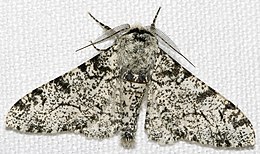Animal Behavior/The Peppered Moth Studies
The Peppered Moth (Biston betularia)
[edit | edit source]
Within one hundred years (1850 to 1950); the dotted whitish form of the peppered moth (Biston betularia) was almost entirely replaced by the melanic (black) form. The melanic form appeared to be best suited for survival against the soot that had collected on forest tree trunks from pollution because the moths could camouflage with their resting area on the tree. The dotted whitish form of the peppered moth was no longer predominant in this environment because they were easily detected and predated on. How does this happen? Many animals have anti-predator adaptations. Adaptations are defined as “a heritable trait that either spread because of natural selection and has been maintained by selection to the present or is currently spreading relative to alternative traits because of natural selection (Alcock, 2001).” Anti-predator adaptations suggest that a heritable trait, which enables the organism to hide from predators by seeking cover against a background, has spread by natural selection because of reproductive success. H.B. D. Kettlewell’s experiments on the peppered moths, as well as, those conducted by R.J. Howlett and M.E.N. Majerus have proven that the peppered moth’s preference for their resting places on trees are anti-predator adaptations.
In 1955, H.B. D. Kettlewell published his study on pepper moths: Selection Experiments on Industrial Melanism in the Lepidoptera. Kettlewell hypothesized that the dotted whitish form of the peppered moth were more likely to be eaten than the melanic form because they could be easily detected against the soot covered trees. His studies showed that the moths that were easily identified by humans were at a higher risk of predation from birds. The dotted whitish form was at higher risk of predation than the melanic form in the polluted environment.
Howlett and Majerus further examined this hypothesis in their study: The Understanding of Industrial Melanism in the Peppered Moth, published in 1987. They tested it by pinning 50 of both forms of the peppered moths on pale and dark tree trunks.
Calculations
[edit | edit source]Moths in Polluted (dark) Woodland
Dotted Whitish Form: (30/50) x 100 = 60% Melanic Form: (20/50) x 100 = 40%
60% - 40% = 20% The Dotted Whitish form is predated on 20% more than the melanic form in the polluted woodland.
Moths in Non-polluted (pale) Woodland
Dotted Whitish Form: (15/50) x 100 = 30% Melanic Form: approx. (30/50) x 100 = 60%
60% - 30% = 30% The Melanic form is predated on 30% more than the dotted whitish form in the nonpolluted woodland.
Their studies showed that the dotted whitish form was preyed on 20% more than the melanic form in the polluted woodland. The melanic form is predated on 30% more than the dotted whitish form in the nonpolluted woodland.
In addition to the difference in predation, their studies also showed that in both the polluted and nonpolluted environments the moths that were located on the limb joints instead of the trunks were less likely to be preyed on.
Howlett and Majerus showed that the dotted whitish form was at a higher risk of predation when resting against the polluted (dark) trees. The melanic form had a greater chance of survival and reproduction because they were less likely to be detected against the soot-covered trees, the same findings of Kettlewell years before. Their experiment proved that the melanic form was an anti-predator adaptation, which is why the dotted whitish form had become so rare. The melanic form had become the dominant trait for survival and reproduction in the polluted woodland.
References
[edit | edit source]- Alcock, John. Animal Behavior: An Evolutionary Approach, Seventh Edition. Massachusetts: Sinauer Associates, Inc., 2001
